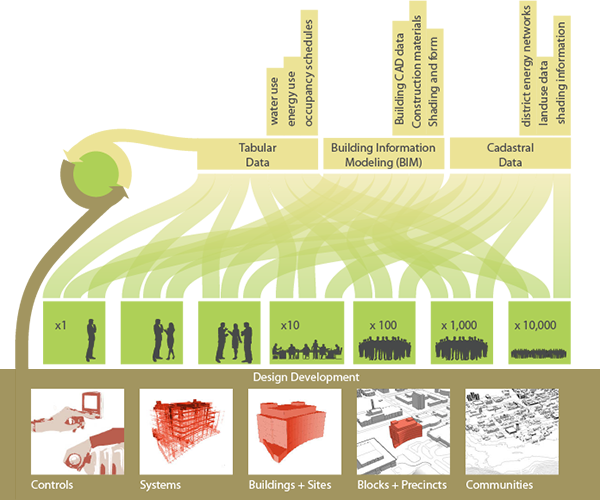
Data, local or on the web, is more useful when combined with data from other sources. Co-investigator Dr. Rachel Pottinger has been leading an exploration on how to integrate data from the building scale (in ifcXML format) with data from campus and city level (in CityGML format). This has also involved needing to integrate some data stored in Geographical Information Systems (GIS) format.
Change in Schemas and Their Integration: Starting from the ARTIFACT data, Dr. Rachel Pottinger, Dr. Sheryl Staub-French, and student Michael Lawrence have been exploring how to handle changing data and schemas that must be coordinated. We are building from the example of having building designs and cost estimates; we assume that two sources need to be kept up to date with each other, but they have little coordination.
The problem abstracts as follows: given a schema I and a schema J, update J as I changes.
Updating J automatically would drastically increase efficiency whenever such coordination occurs.
Recently, we showed when it is more efficient to create a new instance of J instead of updating the existing J instance. This work sheds new light on existing view maintenance work by showing when updates are necessary or when the views should be recomputed from scratch. We also performed a case study where we applied our general techniques to the cost estimation domain. This work has been published:
Michael Lawrence, Rachel Pottinger, Sheryl Staub-French, and Madhav Nepal. Creating Flexible Mappings Between Building Information Models and Cost Information. Automation in Construction. 45. September 2014. pp. 107-118.

An example building design in XML consisting of a few columns and spaces.
During the early design stages of construction projects, accurate and timely cost feedback is critical to design decision making. This is particularly challenging for cost estimators, as they must quickly and accurately estimate the cost of the building when the design is still incomplete and evolving. State-of-the-art software tools typically use a rule-based approach to generate detailed quantities from the design details present in a building model and relate them to the cost items in a cost estimating database. In this paper, we propose a generic approach for creating and maintaining a cost estimate using flexible mappings between a building model and a cost estimate.
Student Involvement
- Undergraduate Arianne Dee led the work on exploring which UBC campus data was stored in which source, particularly in understanding the campus’ GIS data.
- MSc student Lan Wei created a mapping between the ifcXML format and CityGML representations along with creating a mediated schema so that the different sources can be queried simultaneously. This also shed light on how existing techniques to create mediated schemas fail to adequately create something that is both usable and comprehensible.
- Undergraduate student Claire Edgcumbe worked on understanding the quality of ifcXML data and the issues that arise when the desired quality is not available.
- MSc student Baipeng Han worked on how to extract the data from the campus GIS data so that it can be combined with the ifcXML and CityGML data.
- MSc student Melsa Smith created a visualization of the schemas in order to make creating the mapping easier. MSc student Nayantara Duttachoudhury continued this work to help make it easier to visualize the data that is returned by queries.
- MSc student Arni Thrastarson created the initial overview of a system for how to handle updates to cleansed data. MSc student Jessica Wong is extending that work to make an implemented system, which will require extending the theoretical work.
- PhD student Michael Lawrence investigated the relationships between design and cost information and developed a novel approach using queries to create flexible mappings between design and cost views.
Application
The ifcXML, CityGML, and GIS data that we are integrating uses the UBC campus as a case study and we are now working with UBC Building Operations to apply this data set to operations and maintenance tasks.

